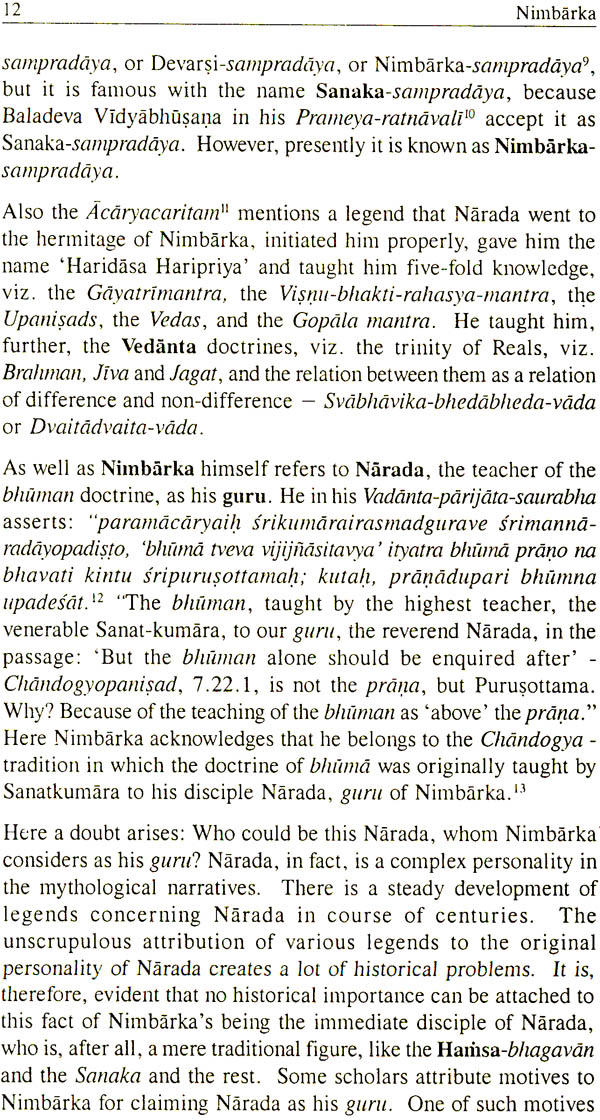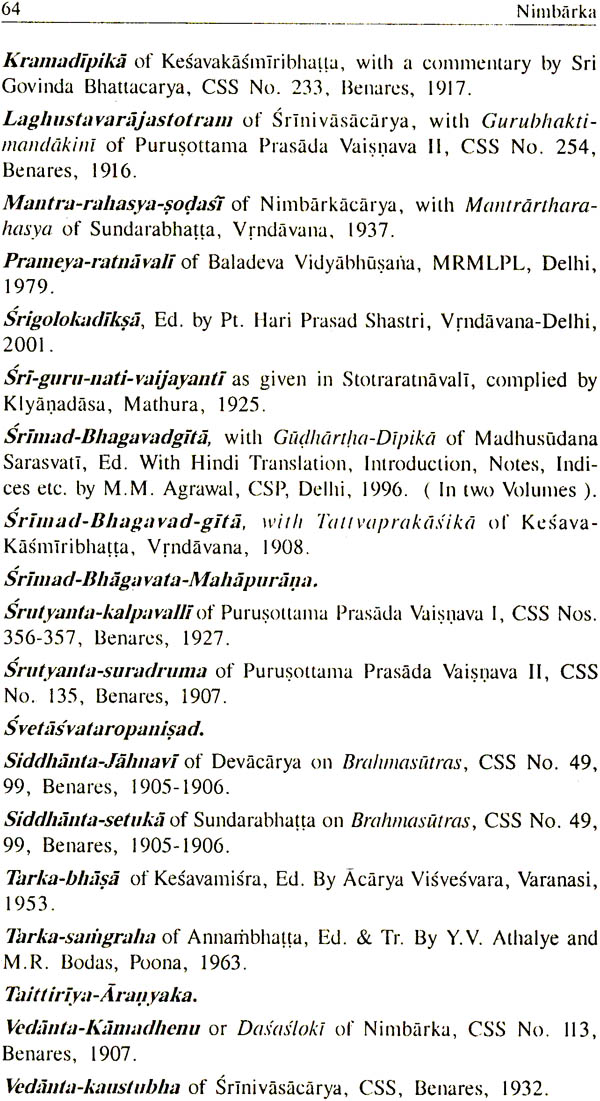
Nimbarka Philosophical Tradition
Book Specification
| Item Code: | IDG818 |
| Author: | Madan Mohan Agrawal |
| Publisher: | Chaukhamba Sanskrit Pratishthan |
| Language: | English |
| Edition: | 2005 |
| ISBN: | 8170843138 |
| Pages: | 77 |
| Cover: | Hardcover |
| Other Details | 9.2" X 6.2" |
| Weight | 310 gm |
Book Description
From the Jacket
Vaisnavism is regarded as one of the most important religions of India. Nimbarka is a shimmering personality among the Vaisnavacaryas. On the devotional plane, the object to be worshipped, according to Nimbaraka, is Radha-Krsna conjointly. Srikrsna is the supreme Lord and Radha his Hiladinisakti. Radha and Krsna are represented as gold and emerald hued splendours. The delineation of Radha is superb. She is captivating the heart of Srikrsna. She is presiding deity of heart of Srikrsna. She is an object of worship- aradhya for Srikrsna Himself, so she is called Radha. This Radha-Krsna cult, to which Nimbarka gives an exclusive prominence, is one of the most popular and influential cults that have ever flourished in India. This is the cult of love and devotion.
The present monograph contains a general summary of Nimbarka-sampradaya. It is hoped that it will be received well by al the students and scholars interested in Nimbarka-school of Vedanta.
About the Author
M.M. Agrawal PhD, D. Litt. Is Professor is Sanskrit at University of Delhi. He is an author of many books and has contributed several papers and articles in India and abroad. Some of his outstanding books are 'The Philosophy of Nimbarka, 'Bhavaprakasana of Saradatanaya', ' Essence of Vaisnavism' , 'Aspects of Indian Philosophy', 'Srimadbhagavadgita' with the commentary Gudharthadipika of Madhusudana Sarasvati {in two Vols}, 'Brahmasutranimbarka-bhasya' with three commentaries, viz. Vedanta-Kaustubha, Vedanta-Kaustubhaprabha, and Bhavadipika {in four Vols}, Six systems of Indian Philosophy (The Sutras of Six Systems of Indian Philosophy with English Translation, Transliteration, introduction and indices), Sarvadarsana-samgraha with its English Translation, Transliteration and Introduction and 'Rasarnavalamkara' of Prakasavarsa with its Hindi Translation, Introduction and indices.
Vaisnavism is regarded as one of the most important religions of India, whatever be the right kind of test in determining the importance of a religious tradition - the amount of the following or the intrinsic worth of the tradition. It is not based upon a mythical fancy of the poets, but has a truth in the personal history of Vasudeva-Krsna. It is the more extensive and almost exclusive cult of the Gopala-Krsna or the Krsna of Gokula. It is a harmonious combination of Absolutism with personal theism. Among the Vaisnavas there are four main sects - Srisampradaya = Visist- advaita of Ramanuja, Brahmasampradaya = Dvaita of Madhva, Rudrasampradaya = Suddhadvaita of Visnusvami and Vallabha and Sanakasampradaya = Dvaitadvaita of Nimbarka.
On the devotional plane, the object to be worshipped, according to Nimbarka, is Radha-Krsna conjointly. Srikrsna is the Supreme Lord and Radha His Hiladinisakti. Radha and Krsna are represented as gold and emerald hued splendours. The delineation of Radha is superb. She is captivating the heart of Srikrsna. She is presiding deity of heart of Srikrsna. She is an object of worship - aradhya for Srikrsna Himself, so she is called 'Radha', This Radha-Krsna cult, to which Nimbarka gives an exclusive prominence, is one of the most popular and influential cults that have ever flourished in India. This is the cult of love and devotion.
The following pages contain a general summary of Nimbarka- sampradaya. I had prepared them in the form of an article, entitled: "Nimbarka Philosophical Tradition", submitted to 'National Seminar on Indian Intellectual Traditions', Poona, 2003. Now I am presenting them in a monograph form with some improvements. It is hoped that it will be received well by all the students and scholars interested in Nimbarka-school of Vedanta.
This preface will remain incomplete if I do not give thanks to my dear son Mr. Rama Prapanna Agrawal for helping me in arranging and preparing the press copy of the manuscript. Mr. Niraj Gupta deserves my thanks for speedy publication of this book with accurate printing and an excellent get up.
| Preface | 5 | ||
| 1 | Acarya-parampara: | 11 | |
| Nimbarkacarya | 13 | ||
| Srinivasacarya | 14 | ||
| Visvacarya | 15 | ||
| Purusottamacarya | 15 | ||
| Devacarya | 16 | ||
| Sundarabhatta | 17 | ||
| Kesvakasmiribhatta | 18 | ||
| Sribhatta | 19 | ||
| Harivyasadeva | 20 | ||
| Svabhudeva = Purusottamaprasada I | 21 | ||
| Purusottamaprasada II | 22 | ||
| Anantarama- devacarya | 22 | ||
| Lalitasarana- devacarya | 23 | ||
| Gopalasarana-devacarya | 23 | ||
| Parasuramadeva | 24 | ||
| Sriji Radha-sarvesvara-sarana-devacarya | 24 | ||
| 2 | Philosophy | 27 | |
| 1. | The Trinity of Reals | 27 | |
| 1.1 | The Concept of Brahman | 27 | |
| 1.2 | The Concept of Jiva | 29 | |
| 1.3 | The Concept of Jagat | 32 | |
| 1.4 | Relation between Brahman, Jiva and Jagat | 33 | |
| 2. | Knowledge and the Methods of Knowledge | 36 | |
| 2.1 | Nature of Knowledge | 36 | |
| 2.2 | The Methods of Knowledge | 38 | |
| 2.2.1 Pratyaksa- Perception | 38 | ||
| 2.2.2 Anumana-Inference | 39 | ||
| 2.2.3 Upamana-Comparison | 40 | ||
| 2.2.4 Sabda- Word or Verbal-testimony | 40 | ||
| 2.2.5 Anupalabdhi- Non-perception or Non-apprehension | 40 | ||
| 3. | Liberation- Moksa | 41 | |
| 3.1 | The Concept of Moksa | 41 | |
| 3.2 | The Means of Moksa- The Sadhanas | 41 | |
| 3.2.1 Karman | 42 | ||
| 3.2.2 Vidya | 42 | ||
| 3.2.3 Upasana | 42 | ||
| 3.2.4 Prapatti | 42 | ||
| 3.2.5 Gurupasatti | 42 | ||
| 3 | Contribution | 45 | |
| 1. | Contribution to Metaphysics | 45 | |
| 1.1 | The Trinity of Reals | 45 | |
| 1.2 | Reality of the Jagat | 46 | |
| 2. | Contribution of Logic and Epistemology | 48 | |
| 2.1 | The Significance of Perception | 49 | |
| 2.2 | The Supreme Sgnificance of Scriptural-testimony | 49 | |
| 3. | Contribution to Ethics | 50 | |
| 4. | Conclusion | 51 | |
| References | 53 | ||
| Bibliography | 63 | ||
| index | 69 |










